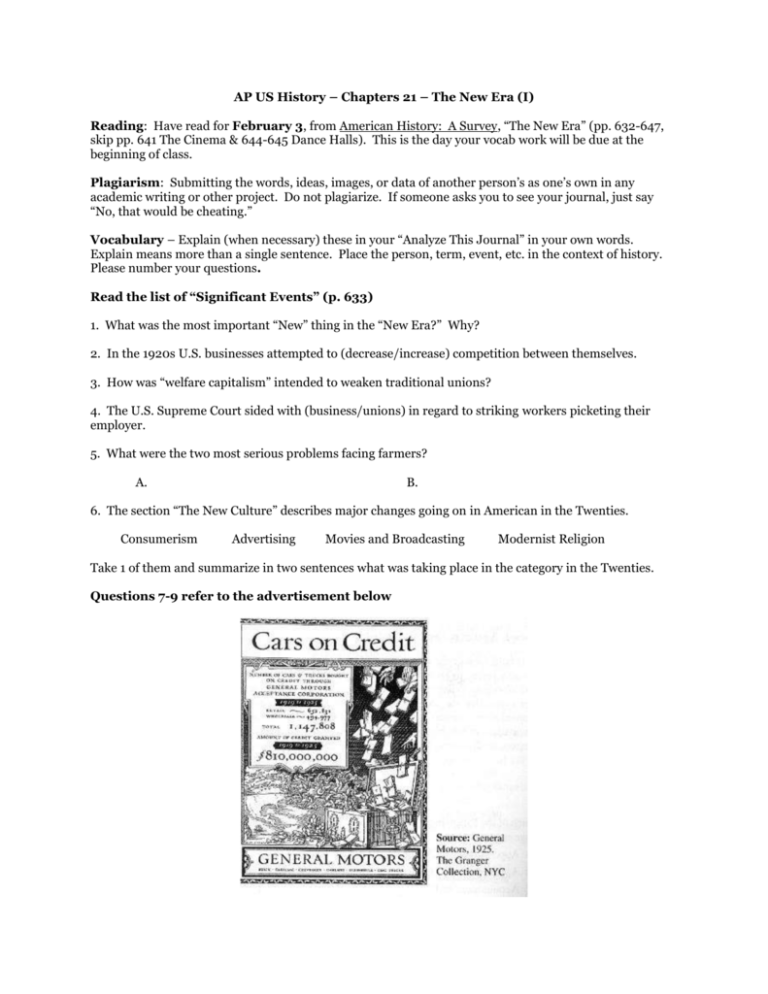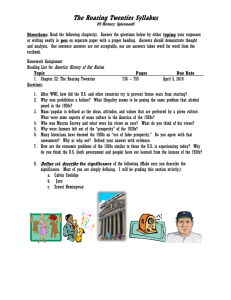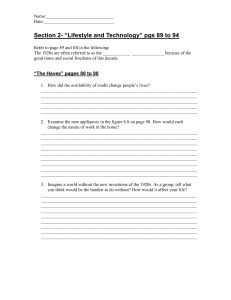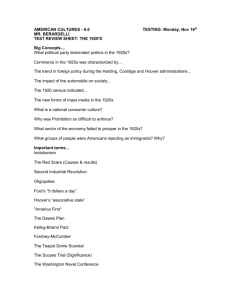Week of February 1
advertisement

AP US History – Chapters 21 – The New Era (I) Reading: Have read for February 3, from American History: A Survey, “The New Era” (pp. 632-647, skip pp. 641 The Cinema & 644-645 Dance Halls). This is the day your vocab work will be due at the beginning of class. Plagiarism: Submitting the words, ideas, images, or data of another person’s as one’s own in any academic writing or other project. Do not plagiarize. If someone asks you to see your journal, just say “No, that would be cheating.” Vocabulary – Explain (when necessary) these in your “Analyze This Journal” in your own words. Explain means more than a single sentence. Place the person, term, event, etc. in the context of history. Please number your questions. Read the list of “Significant Events” (p. 633) 1. What was the most important “New” thing in the “New Era?” Why? 2. In the 1920s U.S. businesses attempted to (decrease/increase) competition between themselves. 3. How was “welfare capitalism” intended to weaken traditional unions? 4. The U.S. Supreme Court sided with (business/unions) in regard to striking workers picketing their employer. 5. What were the two most serious problems facing farmers? A. B. 6. The section “The New Culture” describes major changes going on in American in the Twenties. Consumerism Advertising Movies and Broadcasting Modernist Religion Take 1 of them and summarize in two sentences what was taking place in the category in the Twenties. Questions 7-9 refer to the advertisement below 7. Which of the following trends of the 1920s is most clearly portrayed in this advertisement? (A) The expansion of auto dealers throughout the country (B) The use of extended payment plans to purchase consumer goods (C) The emergence of General Motors as the largest company (D) The growth of middle-class incomes 8. Many historians criticize the economy that developed during the 1920s. Which of the following statements best supports that point of view? (A) Consumerism weakened the moral character of the nation (B) The growth of the auto industry badly hurt the railroads (C) Advertising was based on gaining status and popularity (D) The boom was based on speculation and borrowed money 9. Which of the following groups faced the most difficult economic conditions during the 1920s? (A) Non-unionized workers in older industries (B) Assembly line workers in factories (C) Farmers and many rural areas (D) Businesses that did not accept credit cards 10. Think about your opinion on contraception and family planning. Now, place yourself in the Twenties. Do you think you would have (Liked/Disliked) Margaret Sanger? Explain why. (If you can’t make up your mind explain why) 11. What new attitudes toward motherhood, sex, and leisure developed in the 1920s, especially among middle-class women? Questions 12-13 refer to the excerpt below. The problem of birth control has arisen directly from the efforts of the feminine spirit to free itself from bondage.... The basic freedom of the world is woman's freedom. A free race cannot be born of slave mothers. A woman enchained cannot choose but give a measure of that bondage to her sons and daughters. No woman can call herself free who does not own and control her body. No woman can call herself free until she can choose consciously whether she will or will not be a mother. —Margaret Sanger, Woman and the New Race, 1920 12. Which of the following developments in the 1920s would most directly support the author's sentiments in the excerpt? (A) Liberalized divorce laws (B) Labor-saving household appliances (C) Employment as secretaries, nurses, and teachers (D) New fashions and hair styles 13. Which of the following most influenced thinking about sexual behavior during the 1920s? (A) Research of Frederick Taylor (B) Writing of the Lost Generation (C) Advertising of consumer products (D) Popularization of Sigmund Freud 14. The Sheppard-Towner law (was consistent with/violated the philosophy of) laissez-faire. 15. What was the most important change that took place in the area of “Education and Youth?” 16. Name two American authors who were important in the Twenties. Place a check next to an author you have read. 17. American authors in this era was described as being disillusioned and disenchanted. Why were they so unhappy? Questions 18-20 is based on the excerpts below. "I couldn't forgive him or like him, but I saw that what he had done was, to him, entirely justified. It was all very careless and confused. They were careless people, Tom and Daisy—they smashed up things and creatures and then retreated back into their money or their vast carelessness, or whatever it was that keep them together, and let other people clean up the mess they had made." —F. Scott Fitzgerald, novelist, The Great Gatsby, 1925 "Never was a decade snuffed out so quickly as the 1920's. The stock market crash was taken as a judgment pronounced on the whole era, and, in the grim days of the depression, the 1920's were condemned as a time of irresponsibility and immaturity." -William E. Leuchtenburg, historian. The Perils of Prosperity, 1959 18. Briefly explain ONE social development in the 1920s that supports the Fitzgerald quote. 19. Briefly explain ONE economic development of the 1920s that supports the Leuchtenburg argument. 20. Briefly explain ONE argument that supports that the 1920s made a positive contribution to the longterm prosperity of the United States. Missing Seminar – If you miss seminar you may still receive participation points by writing two pages (front back) on the following prompt in your Vocab Journal and turning it in the next time you are in class. Prompt - Describe and account for the rise in nativism in American society from 1900 to 1930. AP US History – Chapters 21 – The New Era (II) Have read American History: A Survey for February 8 “The New Era” (pp. 647-656). This is the day your Vocabulary Journal will be due at the beginning of class. Plagiarism: Submitting the words, ideas, images, or data of another person’s as one’s own in any academic writing or other project. Do not plagiarize. If someone asks you to see your journal, just say “No, that would be cheating.” Vocabulary – Explain (when necessary) these in your “Vocabulary Journal” in your own words. Explain means more than a single sentence. Place the person, term, event, etc. in the context of history. Please number your questions. 1. A Renaissance is defined as a “revival of intellectual or artistic achievement and vigor.” Why could the events in Harlem in the Twenties be considered a Renaissance? 2. Questions 2-4 is based on the excerpt below. "Through his artistic efforts the Negro is smashing this immemorial stereotype faster than he has ever done through any other method he has been able to use.... He is impressing upon the national mind the conviction that he is an active and important force in American life; that he is a creator as well as a creature; that he has given as well as received; that he is the potential giver of larger and richer contributions.... "I do not think it too much to say that through artistic achievement the Negro has found a means of getting at the very core of the prejudice against him by challenging the Nordic superiority complex. A great deal has been accomplished in this decade of 'renaissance.'" —James Weldon Johnson, poet and secretary of the NAACP, Harper's, 1928 2, Briefly explain ONE way the Harlem Renaissance supported the point of view in the excerpt. 3. Briefly explain ONE example of an African American artist's achievement from the era that would support this excerpt. 4. Briefly explain what the author most likely meant by "the very core of prejudice" faced by African Americans in the 1920s. 5. Why do you think Prohibition was finally ended in 1933? National Origins Act (1924) made immigration to this nation (easier/more difficult). 6. The targets of Klan violence had been in this nation for a while. Why did the level of violence against them increase so much in the Twenties? 7. Would you have been a target of Klan violence if you had lived in the Twenties? (Yes/No) (Consider your religion, ethnicity, etc.) 8. The Scopes Monkey Trial was (Lost/Won) by the Fundamentalist side. 9. Which of the following was the most important in Al Smith losing votes? His (race/ethnicity/religion/marital status). 10. Who would you have voted for Harding or Coolidge? Explain 11. The decision in Lochner vs. New York (1905) declared the New York law limiting working hours (Constitutional/Unconstitutional) 12. The decision in Batley vs. Drexel Furniture Co. (1922) declared the federal law limiting child labor (Constitutional/Unconstitutional) 13. The decision in Adkins vs. Children's Hospital (1923) declared the Washington, D.C. minimum wage law (Constitutional/Unconstitutional) 14. The decision in U.S. vs. US Steel the court made enforcement of anti-monopoly legislation (easier/more difficult). 15. Briefly explain ONE example of how religion and science were a source of conflict in American society during the 1920s. 16. Briefly explain ONE development during the 1920s that changed attitudes toward Prohibition. 17. Briefly explain ONE important difference in the immigrant legislation of the 1920s in comparison to earlier periods. 18. Briefly explain ONE example of how the media of 1920s contributed to development of a shared national culture. 19. Briefly explain ONE development that caused the disillusionment among writers of the 1920s. 20. Briefly explain ONE important artistic response during the 1920s and 1930s to industrial development or urban experience. Questions 21-23 refer to the excerpt below. "A widely held view of the Republican administrations of the 1920s is that they represented a return to an older order that had existed before Theodore Roosevelt and Woodrow Wilson became the nation's chief executives. Harding and Coolidge especially are seen as latter-day McKinleys, political mediocrities who peopled their cabinets with routine, conservative party hacks of the kind almost universal in Washington from the end of the Civil War until the early 20th century. In this view, the 1920s politically were an effort to set back the dock." —David A. Shannon, historian, Between the Wars: America, 1919-1941, 1965 21. Which of the following most directly supports the argument found in the above excerpt? (A) Appointment of Charles Evans Hughes as Secretary of State (B) Appointment of Harry M. Daugherty as Attorney General (C) Appointment of Herbert Hoover as Secretary of Commerce (D) Selection of Calvin Coolidge for Vice President 22. Which of the following cites an event that mostly clearly challenges the interpretation expressed in the above excerpt? (A) The Washington Conference of 1921 (B) The Fordney-McCumber Tariff of 1922 (C) The Tea Pot Dome leases (D) The veto of McNary-Hagen bill of 1928 23. The administration of which of the following presidents who served between 1865 and 1900 most closely resembles the corruption of the Harding administration? (A) Andrew Johnson (B) Ulysses S. Grant (C) James Garfield (D) William McKinley 24. THINK AS A HISTORIAN: ADDING DETAILS FOR CONTEXTUALIZATION Adding information about the historical context of an event helps the reader understand its significance. Which THREE of the sentences below best demonstrate the use of contextualization? 1. The corruption in the Harding administration involving Albert Fall and Harry Daugherty was serious. 2. The Kellogg-Briand Treaty expressed a reaction against war that could be seen throughout Europe and eastern Asia. 3. In his novels, F. Scott Fitzgerald reflected the materialism, consumer culture, and fascination with wealth that dominated the 1920s. 4. The Harlem Renaissance was even more impressive because it occurred during a period when the KKK and anti-immigrant feelings were on the increase. 5. Grant Wood appreciated the subtle beauty of Iowa and other rural parts of the United States. Missing Seminar – If you miss seminar you may still receive participation points by writing two pages on the following prompt in your Analyze This Journal and turning it in the next time you are in class. Prompt - In what ways did economic conditions and developments in the arts and entertainment help create the reputation of the 1920s as the Roaring Twenties. Total Recall Review 1. welfare capitalism 2. labor issues 3. National Origins Act (1924) 4. New consumer goods 5. Margaret Sanger 6. farm problems 7. Sheppard-Towner Act 8. Ku Klux Klan 9. Lochner vs. New York (1905) 10. Adkins vs. Children's Hospital (1923) 11. Batley vs. Drexel Furniture Co. (1922)







